Pigeon-holing today's telecom equipment * What goes where? * Product prospects * Startups galore
February 27, 2001

There was a time when telecom equipment was easily defined. The basic plumbing was provided by Sonet kit, and services that ran over it each had their own dedicated devices -- telephone switches for voice, routers for Internet traffic, and so on.
Not any more. The opening of telecom services to competition and the arrival of optical networking technologies has led to a complex and confusing marketplace for equipment -- one that’s continually on the move as the service provider market itself evolves.
On the one hand, the vocabulary is changing as the fundamental architecture of telecom networks shifts from voice to data-centric, and as new developments like DWDM (dense wavelength-division multiplexing) and optical switches rewrite the rule books on how telecom networks should be designed.
On the other hand, the arrival of so many different types of carrier -- wholesalers, retailers, local carriers, long-distance carriers, ISPs, ASPs, and so on -- has led to a much wider range of equipment requirements.
Competition among carriers has also led to a much greater emphasis on cutting costs and offering higher-value services, and that's stimulated more product innovations.
The upshot is an explosion of new equipment categories, some of them genuine and some of them invented by marketing folk in their efforts to set their products apart from rival offerings.
And that’s leading to general confusion. It’s tough to keep track of all the new terms, like service-aware switches and optical packet nodes, and even harder to figure out what the differences are among them. To make matters worse, the names of product categories have a habit of changing as new buzz words come into fashion.
As a result, doing any sort of competitive analysis is tough, and that’s a big problem for everybody -- vendors trying to identify rivals, service providers trying to shortlist suppliers, and investors trying to pick winners.
That’s where this report comes in. It outlines a taxonomy for new-architecture telecom networks, identifying groups of equipment and showing where they sit in our view of things. Our goal is to help folk compare like with like, in the interests of oiling the wheels of competition.
The report starts by explaining our positioning matrix, which is largely based on the work of Sean Welch, vice president for marketing and sales at Tenor Networks Inc..
It then defines different product categories, shows how they fit into this matrix, and examines how issues such as the internal structures of some service providers might steer different types of operator towards different types of product.
The report then steps through each product category, defining it, showing where it fits in our positioning matrix, identifying key trends and giving our assessment of its prospects. Each page also lists vendors offering products and gives links to related Light Reading stories.
Links to the individual categories are given below:
DWDM Systems
(Metro, Enterprise, and Long Haul)
Optical Access
Multiservice Provisioning Platforms (MSPPs)
(Next-generation Sonet, Multiprotocol DWDM, and Optical Ethernet/IP).
Optical Switching
Service-Aware Switches
(Core MPLS Switches, Optical On-Ramps, and Multiservice Edge Switches)
IP Service Switches
Optical Packet Nodes
(Metro and Core)
Multilayer Data Switches
(Layers 2-3 and Layers 4-7)
Next-Generation Routers
(Edge/Aggregation and Core}
It’s important to realize that grouping products into categories like this is far from an exact science. We’ve done our best, but we would welcome input so that we can refine our assessments, add further companies to our lists, and possibly create new categories as the market continues to evolve.
If you want to do this privately, please send comments to [email protected]
Next page: Functional Framework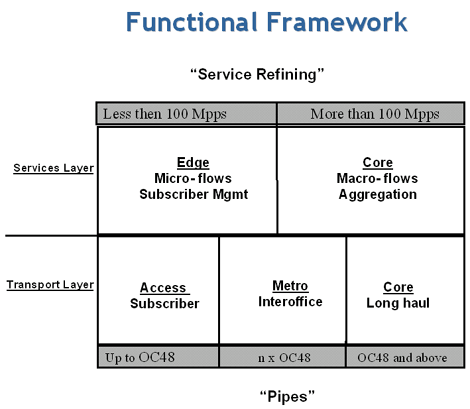 This diagram offers a way of viewing next-generation telecom networks from a functional point of view. As noted, it's based on work by Sean Welch of Tenor Networks.
This diagram offers a way of viewing next-generation telecom networks from a functional point of view. As noted, it's based on work by Sean Welch of Tenor Networks.
The key points are these:
The taxonomy focuses on the equipment that Light Reading covers. It doesn’t include customer premises equipment, low-speed access devices, telephone switches, and wireless equipment.
Although telecom networks are often multilayer, the division that really matters is between the bottom transport layer and the top services layer. This is often embedded in incumbent service providers’ organizational structure. A single "horizontal" business unit looks after the transport network and provides bandwidth to a number of "vertical" business units offering different services such as telephony, Internet access, frame relay, and so on.
The transport layer provides the basic mechanisms for carrying bits over fiber. This includes putting multiple wavelengths over fibers using DWDM and linking together those wavelengths with optical switches. It also includes packing wavelengths with lower bandwidth circuits using Sonet, or using the wavelengths to carry gigabit Ethernet traffic. Performance is measured in bits per second.
The transport layer is divided into three vertical segments. Access, between the subscriber and the carrier’s point of presence, is characterized by bandwidths of up to 2.5 Gbit/s (OC48). These access connections feed into bigger pipes (up to multiple OC48s) in metro networks. They in turn feed into even bigger pipes (up to OC192) in long-haul networks.
In the services layer, packets of data are handled individually or as flows (strings of packets associated with the particular user and application). Older technologies include frame relay and ATM (asynchronous transfer mode). MPLS (multiprotocol label switching) is emerging as a possible ATM replacement. Performance is measured in packets per second (pps).
The services layer is divided into “edge” and “core” vertical segments, with 100,000 pps marking the dividing line.
The edge segment is characterized by microflows, relatively small bursts of packets. The big issue is subscriber management -- dealing with huge numbers of customers in a cost-effective manner. The equipment used in this space is analogous to the Class 5 switches used in telephone networks -- switches that handle hundreds of thousands of connections to individual buildings and funnel this traffic onto carrier backbones.
The core segment is characterized by macroflows, and the big issue is aggregation -- marshalling large volumes of traffic in order to optimize performance while minimizing costs. The equipment here is analogous to Class 4 telephone switches, those with a relatively small number of ports, each handling huge volumes of traffic.
Next Page: Pigeon Holes
Now comes the task of grouping today's equipment into categories and showing where they're located in the functional framework described on the previous page.
This is where the fun begins, because life isn't really that simple. The trend towards consolidating the functions of several devices into a single box reduces the likelihood of vendors having directly comparable products. As already noted, this is compounded by the growing diversity of carrier types, each having its own particular equipment requirements.
A mouse is easily distinguished from an elephant. But at what point does it become a rat? And where to put the platypus?
All of this is complicated even further by the reluctance of vendors to be pigeon-holed. In some cases, this is because they're startups in stealth mode, hoping to spring a surprise on the competition. In other cases, it's because vendors don't want to identify competitors, and may want to leave the way clear for them to switch their target market without getting noticed.
The other issue we bore in mind was the need to limit the number of product categories so that we didn't defeat the purpose of our exercise. As a result, we settled on nine categories, some of which include subdivisions.
Even so, we ended up with quite a confusing overall picture: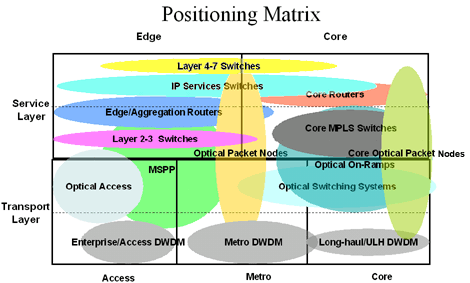 Don't panic! The rest of the report steps through this chart, bubble by bubble, defining the product category, identifying key trends, and giving our assessment of the prospects. Each page also lists vendors making products and gives links to related articles in Light Reading.
Don't panic! The rest of the report steps through this chart, bubble by bubble, defining the product category, identifying key trends, and giving our assessment of the prospects. Each page also lists vendors making products and gives links to related articles in Light Reading.
Here's our hyperlinked list of product categories:
DWDM Systems
(Metro, Enterprise, and Long Haul)
Optical Access
Multiservice Provisioning Platforms (MSPPs)
(Next-generation Sonet, Multiprotocol DWDM, and Optical Ethernet/IP)
Optical Switching
Service Aware Switches
(Core MPLS Switches, Optical On-Ramps, and Multiservice Edge Switches)
IP Service Switches
Optical Packet Nodes
(Metro and Core)
Multilayer Data Switches
(Layers 2-3 and Layers 4-7)
Next-Generation Routers
(Edge/Aggregation and Core}
We've omitted traditional Sonet/SDH equipment from this exercise, even though it's clearly a huge product category. In fact, that's why we left it out. It would have occupied the upper portion of the transport layer in its entirety, and the list of vendors would have been almost endless.
It's also worth noting that we ran into a couple of examples of vendors and products that we simply couldn't position in our matrix. One of them is the "wholesale router" from Allegro Networks (see Allegro Holds a House Party ). Another is the "virtual router" from Crescent Networks (see Crescent Comes Out).
One final point about the positioning matrix: Quite a few product categories span the dividing line between the transport and services layer -- notably the MSPPs and optical packet nodes. As a result, they're more likely to appeal to new carriers than incumbents.
Why? Two reasons.
On the positive side, these products typically combine functions that would have previously required multiple boxes, so they suit service providers that don't have any existing gear and want a quick way of offering a complete range of services.
On the negative side, these products are likely to duplicate equipment that incumbent carriers already have in their points of presence.
Much more importantly, they don't fit in with the organizational structure of incumbents, where the transport network is handled by one division and the services are provided by others. These folk simply won't buy a box that requires them to share the responsibility for installing and managing it.
It's also worth remembering that incumbents still account for a large proportion of the market for telecom equipment (see U.S. Carriers to Spend $88B in 2000).
Next Page: DWDM Systems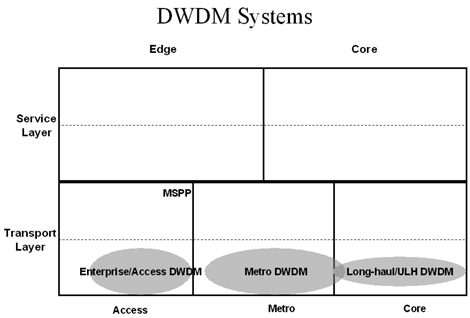 Dense wavelength-division multiplexing (DWDM) is a direct descendant of the erbium doped fiber amplifier (EDFA), which has the capability of optically amplifying multiple information-carrying wavelengths in a single optical fiber.
Dense wavelength-division multiplexing (DWDM) is a direct descendant of the erbium doped fiber amplifier (EDFA), which has the capability of optically amplifying multiple information-carrying wavelengths in a single optical fiber.
Coupling passive wavelength-division multiplexing techniques with the EDFA allowed vendors such as Pirelli, Ciena, and Lucent in 1995 to kick off one of the most important telecommunications equipment markets in history.
At that time, selling DWDM systems was easy: Carriers needed more capacity than their fiber networks could handle. DWDM delivered, creating multiple “virtual” fiber networks within a single optical fiber.
Nortel, Fujitsu, and Hitachi have integrated DWDM into their Sonet/SDH equipment. Other vendors have promoted "open" systems that can be used in conjunction with any vendor's equipment and are not limited to carrying Sonet.
Key Trends
The application of DWDM in telecommunications networks is already well established in long-haul networks and is greatly expanding, creating a number of distinct submarkets:
1) Enterprise DWDM
Using very low-cost DWDM to expand the capacity of private fiber networks. Often used to multiplex a number of ESCON, FICON, Fibre Channel, or gigabit Ethernet links onto a single fiber.
2) Metro DWDM
Low-cost DWDM systems designed for rings under 500 kilometers, most under 100km, in metro areas. A segment still waiting to take off. There was significant interest around this segment in recent years, but the influx of cheap fiber from fiber wholesalers has somewhat dampened enthusiasm.
3) Ultra Long Haul
Very exciting submarket that has the largest potential growth. These are DWDM systems that do not require electrical regeneration at the standard distance of 500km, but rather employ novel optical amplification techniques, such as Raman amplification, to achieve transmission distances of 2000 to 4000km, greatly reducing the costs of optical networks and increasing the speed by which optical circuits can be provisioned.
Carrier Wish ListLonger distances
Smaller footprint
More channels per fiber
Greater capacity per channel
Improved optical channel monitoringOutlook
The outlook remains very strong for DWDM systems. They provide both the capacity and the foundation for an entirely new realm of networking: optical layer networking, which is revolutionizing telecommunications.
DWDM systems are evolving from statically provisioned point-to-point systems, to dynamically reconfigurable optical layer networks, controlled by intelligent software platforms.
As more and more services are derived and provisioned directly from DWDM systems, there will be a continuing emphasis on developing DWDM-based systems that are more tightly integrated with the services layer. This has already given rise to the “optical packet node” and the intelligent optical switch (see Optical Packet Nodes and Optical Switching).
Currently, the most promising DWDM-based systems are the ultra long-haul. These will allow for much more flexible optical backbones to be created by large carriers.
Among the long-haul DWDM systems, the trend is as always: more channels (now 160 per fiber), more capacity, and a smaller footprint. Expansion into the L- and S-bands will occur this year.
The metro DWDM market is growing, but rather slowly, limited by the influx of dark fiber into the metro area and the variety of OC192 (10 Gbit/s) next-gen Sonet systems coming to market.
Related articles in Light Reading
The Ultimate Backbone
Raman Amps: Key to Optical Future
Nortel Spins Past Ciena
DWDM Growth to Explode
WDM: Metro Market Takes Off
Vendors
Traditional DWDM
Alcatel SA (NYSE: ALA; Paris: CGEP:PA)
Ciena Corp. (Nasdaq: CIEN)
Cisco Systems Inc. (Nasdaq: CSCO)/Pirelli SpA
Ericsson AB (Nasdaq: ERICY)
Fujitsu Ltd. (KLS: FUJI.KL)
Hitachi Ltd. (NYSE: HIT; Paris: PHA)
Latus Lightworks Inc.
Lucent Technologies Inc. (NYSE: LU)
Marconi Communications PLC (Nasdaq/London: MONI)
NEC Corp. (Nasdaq: NIPNY)
Nortel Networks Corp. (NYSE/Toronto: NT)
Siemens AG (Frankfurt: SIE)/Optisphere Networks Inc.
Sycamore Networks Inc. (Nasdaq: SCMR)
Enterprise and Metro DWDM
Adva AG Optical Networking (Neuer Markt: ADV)
Alcatel SA (NYSE: ALA; Paris: CGEP:PA)
Ciena Corp. (Nasdaq: CIEN)
Cisco Systems Inc. (Nasdaq: CSCO)/Pirelli SpA
Ericsson AB (Nasdaq: ERICY)
Marconi Communications PLC (Nasdaq/London: MONI)
LuxN Inc.
Network Photonics
Nortel Networks Corp. (NYSE/Toronto: NT)
ONI Systems Inc. (Nasdaq: ONIS)
Siemens AG (Frankfurt: SIE)/Optisphere Networks Inc.
Sorrento Networks Corp. (Nasdaq: FIBR)
Zaffire Inc.
Ultra Long Haul
Ciena Corp. (Nasdaq: CIEN)
Corvis Corp. (Nasdaq: CORV)
Marconi Communications PLC (Nasdaq/London: MONI)/Solstis
Nortel Networks Corp. (NYSE/Toronto: NT)/Qtera Corp.
OptiMight Communications Inc.
PhotonEx Corp.
Siemens AG (Frankfurt: SIE)/Optisphere Networks Inc.
Sycamore Networks Inc. (Nasdaq: SCMR)
Xtera Communications Inc.
Unannounced
Aetian Networks
Celion Networks Inc.
Innovance Networks
Parama Networks Inc.
Photuris Inc.
Solinet Systems Inc.
Tellamon Photonic Networks Inc.
Next Page: Optical Access Optical access systems bring the benefits of fiber all the way to the subscriber, business or residential.
Optical access systems bring the benefits of fiber all the way to the subscriber, business or residential.
This market space has always been challenged by the economics associated with installing and maintaining fiber in areas where copper is king. Fiber to the home (FTTH) has been proposed and ballyhooed for over a decade, though today only thousands of homes have such a luxury. Fiber to the business has fared better, though most often to the very largest bandwidth hungry businesses that are willing to foot the bill.
The bandwidth boom of the last three years has breathed new life into optical access, and a number of vendors have stepped up to the challenge.
One group favors passive optical networks (PONs) that employ low-cost passive optical components (couplers, splitters) to remove as much cost as possible from the fiber access network.
Another is looking to the robust market for local dark fiber to solve the “first mile” fiber crises, and delivering enterprise-oriented optical access systems customized to the needs of business users.
A further bunch of vendors are developing equipment that will enhance cable TV networks so they can carry two-way broadband traffic.
Carrier Wish List
Low cost, ease of management and operation, remote monitoring and configuration, ease of upgrade, interoperability with existing systems.
Outlook
The residential market will take a while. It always does because it relies on RBOCs reaching a comfort level with a new technology. Competitive operators will be pushing the RBOCs into providing more services in the coming years, and this may prompt them to accelerate their FTTH plans. Hard to say. This same argument was made ten years ago.
The business market is another thing. There is significant demand for fiber to the business and a number of vendors and competitive carriers are working together to bring fiber as close to the user as possible.
Fiber can easily accommodate multiple services, bandwidth upgrades, and isolates services over dedicated wavelengths. This makes it an ideal media for business services, and has prompted the formation of optical access startups to address this opportunity.
The PON players are looking stronger each month, even though many in the industry are skeptical about their technology and their viability among carriers that are loath to put something in the first mile that requires specialized technicians to install and maintain.
Related articles in Light Reading
Last Mile Lexicon
PONs: Passive Aggression
Aurora Networks
Quantum Bridge Aims for IPO
PONs: Coming to a Curb Near You
Alloptic
Fibre Channel Market to Triple
Top 10 Trends
Vendors
Passive Optical Networks (PONs)
Alcatel SA (NYSE: ALA; Paris: CGEP:PA)
Alloptic Inc.
Aurora Networks Inc.
BroadLight Inc.
CS Telecom
Fujitsu Network Communications Inc.
Marconi Communications PLC (Nasdaq/London: MONI)
NEC Eluminant Technologies Inc.
OnePath Networks
Paceon
Quantum Bridge Communications Inc.
Terawave Communications
Enterprise Access
Adva AG Optical Networking (Neuer Markt: ADV)
Alloptic Inc.
Appian Communications
LuxN Inc.
Tiara Networks Inc.
Residential Fiber to the Home
ADC Telecommunications Inc. (Nasdaq: ADCT)
Antec Corp. (Nasdaq: ANTC)
Aurora Networks Inc.
C-Cor.net (Nasdaq: CCBL)
Cisco Systems Inc. (Nasdaq: CSCO)
ClearWorks.net Inc.
CS Telecom
Harmonic Inc. (Nasdaq: HLIT)
HomeFiber
Motorola Inc. (NYSE: MOT)
Optical Solutions Inc.
PurOptix
River Delta Networks
Scientific Atlanta Inc. (NYSE:SFA)
Terayon Communication Systems Inc. (Nasdaq: TERN)
Wave7 Optics
Next Page: Multiservice Provisioning Platforms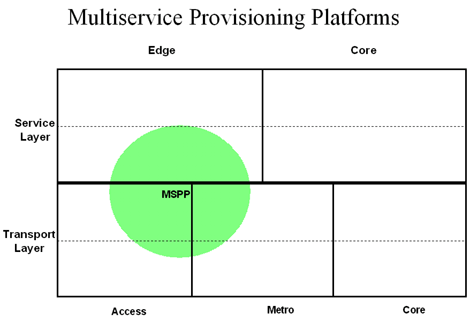 The Multiservice Provisioning Platform (MSPP) was the buzzword of 2000, and enough companies positioned themselves into this space to crowd a theatre. The concept is simple and sound: Since the bulk of new telecommunications services are data oriented, why not “data-optimize” the metro transport network by integrating data aggregation and switching. By the middle of the year, five camps had emerged:
The Multiservice Provisioning Platform (MSPP) was the buzzword of 2000, and enough companies positioned themselves into this space to crowd a theatre. The concept is simple and sound: Since the bulk of new telecommunications services are data oriented, why not “data-optimize” the metro transport network by integrating data aggregation and switching. By the middle of the year, five camps had emerged:
1) Next-generation Sonet
Metro Sonet switches with the ability to directly map data into Sonet channels and deliver them to the edge of the network. These promised to simplify metro network architectures by collapsing Sonet ADMs (add-drop multiplexers), digital crossconnects, and Layers 2 and 3 switches into a single system. The box, in effect, is offered as a toolkit for carriers to respond, however they may choose, to customer demands for new services or higher bandwidth connections. This is the hot segment right now, because it fits most easily into carriers' existing Sonet-based networks. How long the honeymoon lasts is in many ways up to the vendors and their ability to migrate these platforms to support future IP-based services.
2) Multiprotocol DWDM
A rather nebulous category these days, but one that includes those vendors building a metro platform from a metro DWDM base, adding service layer aggregation and intelligence to the system to increase the cost-effectiveness of metro DWDM. Multiprotocol DWDM can be complementary to the other MSPPs listed here, since these systems tend to sit closer to the core than others. Thus, some vendors offer a combination of MSPP platforms for different network implementations.
3) Optical Ethernet/IP
These companies mean to bypass the Sonet layer altogether and build metro platforms that are based on Ethernet and IP, rather than the circuits of Sonet. The reasoning is simple: Why try and stuff data into a voice-oriented network when you can build a data network and adapt voice to it? This makes sense when you consider that over 90 percent of all telecom traffic in a few years will be data, and more than 95 percent of all network connections will be Ethernet. Optical Ethernet asks carriers to entirely rethink their metro networks, but its logic is inescapable. If local area networks are beginning to migrate into the metro network, then why not take LAN technology with them?
4) Multiservice Packet
This sounds a bit like a data switch, which would put it into a services layer category, but a group of companies have come out recently that are using packet switch fabrics to support a mix of data and TDM services over a metro transport system. The key here is transport. Though multiservice packet switches have been around for years, these newcomers use these fabrics in a way uniquely designed for the metro, with aggregation and transport in mind. Some even provide very dense grooming of TDM circuits, adding a distinct value to metro edge service providers.
5) OFDM or Optical Subcarrier Multiplexing
This is clearly a technology-defined category. These vendors each use a multiplexing scheme derived from the satellite industry to multiplex electronic signals into an optical signal using frequency division multiplexing rather than time or wavelength division multiplexing. The technology works. It is very robust, particularly at 10 Gbps, and these companies are quietly getting traction with the ILECs because of their ability to support 10G transmission over old fiber. Keep an eye on this group.
Carrier Wish ListCost-effective, efficient aggregation and transport of multiple services over a common metro infrastructure
Eliminating overlay networks, speeding provisioning of bandwidth and services to customers
Smooth integration of access, edge, and core networks
Support for distributed grooming of DS1s and DS3s
Outlook
When people talk about a shakeout in 2001, they usually mean among the MSPP crowd. There just seems to be too many of them. As carriers continue to talk about scaling back the capital expenditures, and MSPP vendors appear indistinguishable from each other, the likelihood that many won’t remain standing by Christmas this year is a near certainty.
The next-gen Sonet players have fared the best so far. Most have been acquired for substantial sums, and most are already shipping to enthusiastic customers. Metro optical Ethernet is beginning to take hold this year and will likely be a strong contender in 2002 as 10-gigabit Ethernet becomes widely available.
Related articles in Light Reading
Sonet Goes POP
Metro Optical Ethernet
Top 10 Trends
Automate or Suffocate
Shedding Darwin on Light
Vendors:
Next-Gen Sonet
ADC Telecommunications Inc. (Nasdaq: ADCT)
Appian Communications
Ciena Corp. (Nasdaq: CIEN)/Cyras Systems Inc.
Cisco Systems Inc. (Nasdaq: CSCO) (Cerent)
Fujitsu Ltd. (KLS: FUJI.KL)
Geyser Networks Inc.
Jasmine Networks
Marconi Communications PLC (Nasdaq/London: MONI)
Mayan Networks Inc.
Metro-Optix Inc.
Native Networks Ltd.
Redback Networks Inc. (Nasdaq: RBAK) (Siara)
Sycamore Networks Inc. (Nasdaq: SCMR) (Sirocco)
Turin Networks Inc.
Whiterock Networks
Multiprotocol DWDM
Alidian Networks Inc.
Astral Point Communications Inc.
Lucent Technologies Inc. (NYSE: LU) (Chromatis)
LuxN Inc.
Metro Optical Ethernet/IP
Appian Communications
Atrica Systems
Aura Networks Inc.
Dynarc
Extreme Networks Inc. (Nasdaq: EXTR)
Lantern Communications
Luminous Networks Inc.
Nortel Networks Corp. (NYSE/Toronto: NT)
Riverstone Networks (Nasdaq: RSTN)
World Wide Packets Inc.
Multiservice Packet
Coriolis Networks Inc.
Dynarc
Net Insight AB
Ocular Networks Inc.
PacketLight
OFDM or Optical Subcarrier Multiplexing
Centerpoint Broadband Technologies Inc.
Kestrel Solutions
Next Page: Optical Switching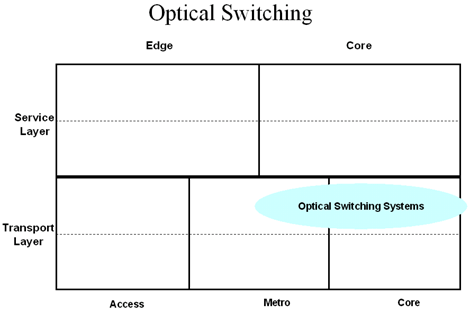 Optical switches are perhaps the most important new network element introduced into the telecommunications network since the EDFA. Though at first glance little more than a large circuit switch at the network core, they are in fact the key to unlocking the power of DWDM networks.
Optical switches are perhaps the most important new network element introduced into the telecommunications network since the EDFA. Though at first glance little more than a large circuit switch at the network core, they are in fact the key to unlocking the power of DWDM networks.
Today, high capacity DWDM networks do little more than provide the “plumbing” for services to travel through. They are designed to be “dumb” and entirely agnostic to the types of services being carried within. That worked well enough while the network grew at a manageable pace and services were in the megabits, but once the Internet took hold and carriers were forced to scale their backbones rapidly, managing all the bandwidth terminating at core network nodes became a massive headache.
In addition, carriers began selling bandwidth in “optical” chunks, OC3s, 12s, and 48s. The only way to provision that kind of capacity quickly from a backbone is via a switched architecture. Without switches, every connection has to be “nailed up,” a process that can take weeks or months, which is unbearably long in the Internet era.
The optical switching market is maturing in 2001, with many of the proposed systems and architectures beginning to take shape.
Today, switches can be classified as OEO (optical-electrical-optical) grooming switches, OEO optical crossconnects, photonic transport switches (often called wavelength-selective crossconnects), and photonic crossconnects.
All these switches share the common function of moving large amounts of capacity from one fiber route to the next in a large distributed optical network. They differ in how they accomplish the task and at what granularity.
Today, the grooming switches have the most traction with carriers because they extend the function of their existing digital crossconnect systems, which top out at OC3 (155 Mbit/s) or OC12 (622 Mbit/s) switching granularity. Optical crossconnects and transport switches tend to be optimized around a core mesh architecture, which takes longer for a carrier to adopt.
Carrier Wish ListA large matrix switch (more than 256 OC48s per system) in a pay-as-you-grow configuration
Grooming of STS-1 circuits in systems of 512 OC48 capacity or less
Switching of any bit rates or protocols in large matrix systems
Ease of implementation. Integration with existing core network systems.
Outlook
This market is destined for greatness. Today, all large carriers agree that optical switches are necessary. There remains a strong debate over just how to implement optical switches, whether to migrate to a mesh backbone architecture, and when to adopt pure photonic systems, but all carriers agree on the need to improve the flexibility of their optical backbones.
It comes down to operations costs and provisioning times. To stay competitive, carriers need to vastly improve both of these, and optical switches are the clear solution.
Today the grooming switches are doing well with carriers because they are much easier to implement than purely photonic switches. These grooming switches will have a place in the core and the network edge, giving them a much longer useful life than their photonic competitors often argue.
Photonic switches address the need for bit-rate and protocol transparency and will be deployed to even further simplify the network backbone. Look for these in 2002, with broader deployment in 2003 and 2004.
Related articles in Light Reading
Optical Illusions
Optical Power Trip
Optical Switch Market Faces Slow Start
Optical Switching: The Next Generation Vendors
OEO Grooming Switches and Crossconnects
Brightlink Networks Inc.
Ciena Corp. (Nasdaq: CIEN)
Cisco Systems Inc. (Nasdaq: CSCO)
Nortel Networks Corp. (NYSE/Toronto: NT)
Sycamore Networks Inc. (Nasdaq: SCMR)
Tellabs Inc. (Nasdaq: TLAB; Frankfurt: BTLA)
Tellium Inc.
Photonic Transport Switches and Crossconnects
Alcatel SA (NYSE: ALA; Paris: CGEP:PA)
Calient Networks Inc.Cinta Corp.
Coree Networks Inc.
Corvis Corp. (Nasdaq: CORV)
Ilotron Ltd.
Inara Networks Inc.
Lucent Technologies Inc. (NYSE: LU)
Luxcore
Nayna Networks Inc.
Network Photonics Inc.
Nortel Networks Corp. (NYSE/Toronto: NT)
Siemens AG (Frankfurt: SIE)
Unique or Unannounced
edgeflow Inc.
Inara Networks Inc.
Movaz Networks
Princeton Optical Systems Inc.
Teraburst
Next Page: Service-Aware Switches The "service-aware switch" isn’t an acknowledged industry term just yet, but it will be soon. It’s a decidedly broad term but, broadly speaking, the service-aware switch is a hardware and software platform built to take service providers out of the commodity IP transport business into enhanced IP services.
The "service-aware switch" isn’t an acknowledged industry term just yet, but it will be soon. It’s a decidedly broad term but, broadly speaking, the service-aware switch is a hardware and software platform built to take service providers out of the commodity IP transport business into enhanced IP services.
These switches have substantial packet processing capabilities and can therefore perform a “deep read” of packets as they enter the switch. They perform the necessary classification, queuing, shaping, and policing of flows to give operators the opportunity to build enhanced IP services around these features.
These switches often collect statistics on this processing and make it available to billing systems or for SLA (service-level agreement) verification and trend analysis. These tend to be Layers 2 and 3 switches, acting as MPLS edge routers in the network, while not performing full routing.
With switches like these, carriers can, ideally, simplify their existing data networks by pushing service creation to the edge of the network -- the metro POPs (points of presence) -- and providing a common adaptation layer, typically MPLS. "Adaptation," by the way, means converting different traffic types into a common format so that everything can be handled by a single set of equipment.
The service-aware switch market is already crowded and in need of segmentation. Like most other equipment categories, a rough division into core and edge systems is useful. In the case of the service-aware switch, each of those can be further segmented to pure IP and hybrids. Here are three currently distinguishable categories of service-aware switches:
1) Core MPLS Switch
The core MPLS switch is meant to complement core routers, providing deterministic IP QOS (quality of service), MPLS adaptation at the edge of the core network, and wire-speed switching of MPLS aggregated flows through the core of the network.
With these platforms, every service is transformed into IP/MPLS, including voice, making these switches quite similar to core ATM switches of old, just much more scaleable and IP-efficient.
The challenge: These are damn hard to build; carriers aren’t convinced deterministic IP QOS is achievable; and many worry that MPLS will become as complex and difficult to scale as ATM. In other words, these companies are at a rather anxious moment in history: They’ll either pay off huge or fizzle (PointReyes looks to be this market’s first casualty). There isn’t much room in between.
2) Optical On-Ramp
This camp is distinct from the MPLS switch crowd in its use of multiple switch fabrics to accommodate a variety of services in their native formats.
These products are improvements on the “bandwidth managers” of recent years offered by Alcatel and Lucent. They terminate private lines and perform grooming and crossconnect of TDM (time-division multiplexing) circuits. They typically have an ATM fabric to manage data traffic, and now, in this iteration, have a means of migrating these services to MPLS.
They reside at the same location as the core MPLS switch -- they just don’t require that everything be converted to MPLS. This makes them more palatable to the large entrenched carriers that aren’t able to make wholesale changes to their network cores as quickly as some of the newer entrants or greenfield operators.
3) Multiservice Edge Switch
Instead of switch fabrics over 100 Gbit/s like the core switches above, these tend to have fabrics in the 10- to 100-Gbit/s range, and focus their attention on micro-flows (below DS3) rather than the macro-flows handled by core switches. Because these systems reside much closer to the end user, they are often responsible for true service creation, often performing edge aggregation and routing functions. Some are based on ATM, others on IP and MPLS. The key here is multiservice, which means most of this group will strive in some way to support many protocols, many services. Thus, the emphasis going forward will be on software and scalability. That said, what constitutes scalability will be interesting to watch. Some will offer multiple OC-192 interfaces, stretching this category into the core, while others will focus on density and a small form factor. This is a tough group of companies to categorize because they all differ on what degree they support switching, routing, and multiple protocols.
Carrier Wish ListIncrease the revenue associated with their Internet backbone expansions
Migrate services infrastructure to a common IP-based platform
Speed delivery of services
Make IP services as deterministic as existing frame and ATM services
As with all other networking markets: density, scaleability, pay-as-you-grow upgrade path
Outlook
The outlook for each of these products differs, based on their target applications and carrier groups. The core MPLS switches have to overcome the increasingly strong presence of Juniper as a core MPLS leader in routing. Optical onramps have to prove that there remains a lasting need for large-scale bandwidth managers at the core of RBOC and IXC (inter-exchange carriers) data networks. Edge services switches must compete against edge routers from the likes of Cisco, Unisphere, Laurel Networks, Juniper, and Riverstone, which won't be easy. IP services switches have to find carriers that are willing to take the plunge into IP services.
The recent experience of AduroNet in Europe (see below) illustrates how difficult it is to make a business out of IP services if you’re a startup. This may be the province of the large IXCs, which means only two or three vendors can survive.
That said, it’s important to realize how important all these products are to the inevitable migration of the public network from a multilayered, multiprotocol network to one that is flatter, simpler to manage, and based on an IP-over-optical architecture. Along the way, companies will make bets on technologies or solutions that will fail, but the idea is in line with the demands of all carriers.
Related articles in Light Reading
The Service-Aware Switch
Automate or Suffocate
AduroNet Goes Bust
Shutdowns Send Dark Message
Maple Gets $50M for MPLS Box
Vendors Serve Up Provisioning Smorgasbord
Équipe Communications Corp.
Vendors
Core MPLS Switch
Maple Optical Systems
Point Reyes Networks Inc. R.I.P.
Tenor Networks Inc.
Vivace Networks
Optical On-Ramp
Alcatel SA (NYSE: ALA; Paris: CGEP:PA)
Équipe Communications Corp.
Lucent Technologies Inc. (NYSE: LU)
Marconi Communications PLC (Nasdaq/London: MONI)
Nortel Networks Corp. (NYSE/Toronto: NT)
Tellabs Inc. (Nasdaq: TLAB; Frankfurt: BTLA)
Multiservice Edge Switch
Alcatel SA (NYSE: ALA; Paris: CGEP:PA)
Gotham Networks
Network Equipment Technologies Inc.
Quarry Technologies Inc.
Redback Networks Inc. (Nasdaq: RBAK) (Siara)
WaveSmith Networks Inc.
Unannounced
Bravida Corp.
Overture Networks
Mahi Networks Inc.
Next Page: IP Service Switches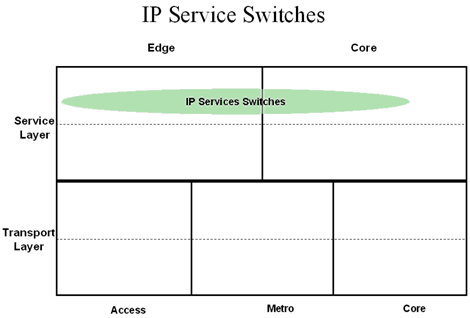 These are like core MPLS switches but focus exclusively on IP. They don't include adaptation capabilities that would enable them to handle other types of traffic.
These are like core MPLS switches but focus exclusively on IP. They don't include adaptation capabilities that would enable them to handle other types of traffic.
Their bread and butter is the VPN (virtual private network), and hopes are tied to a rapidly emerging VPN market in 2001 and 2002. So far, the outlook is good for these players. Their goal is clear and straightforward (they will never be called "God boxes"), and VPNs are catching on among large and medium-sized businesses.
The IP services switch may reside in the access, edge, or core of networks, depending on the service provider network topology and services mix.
In the access network they offer a significant degree of customization of IP-based services, though they may stretch the limits of carriers' network operations and management systems.
At the edge, where most sit today, they often perform the role of aggregation edge router and IP services switch, blending two product categories together. The key applications driving these systems are VPNs and managed security. At the core (or edge of the core, as the location is often called), these systems perform a significant degree of aggregation and switching, often alongside core Internet routers. All of these systems are beginning to adopt MPLS as a scheme to label service-specific flows for transport on the core network.
Outlook
This one depends on whom you talk to. Most people looking years ahead agree unanimously that IP-based services will rule the telecom landscape. VPNs are just a start. All manner of services, be it voice, video, multimedia, collaborative computing, whatever, will be supported over a robust IP network infrastructure. IP service switches will be there to customize services for individual users or businesses and provide the necessary uplinks to OSS and billing support, as well as providing a solution for the mass customization of IP services.
Opinions differ as to when. VPNs are beginning to show some life in 2001, but many specialized service providers are looking weak this year.
Does this mean that IP services will become the stuff of large carriers, or will specialists simply have to adapt their business models to a new market reality? Our guess, for now, is: Watch the big guys. Global Crossing Ltd. (NYSE: GX), Qwest Communications International Corp. (NYSE: Q), and the big three IXCs -- AT&T Corp. (NYSE: T), Sprint Corp. (NYSE: FON), and WorldCom Inc. (Nasdaq: WCOM) -- have the infrastructure to support IP services today, without having to bet the farm on their success.
Related articles in Light Reading
VPNs Are Alive and Well
Accordian Intros 'OnsitePOP' Platform
Campio Communications Inc.
Celox Comes Out
Corona Intros IP Service Platform
Spring Tide Sells Out
CoSine Soars On Debut
Shasta La Vista
Vendors
Accordion Networks Inc.
Celox Networks
Cisco Systems Inc. (Nasdaq: CSCO)
Corona Networks Inc.
CoSine Communications Inc. (Nasdaq: COSN)
Ennovate Networks
Lucent Technologies Inc. (NYSE: LU) (SpringTide)
Nortel Networks Corp. (NYSE/Toronto: NT) (Shasta)
Quarry Technologies Inc.
Next Page: Optical Packet Nodes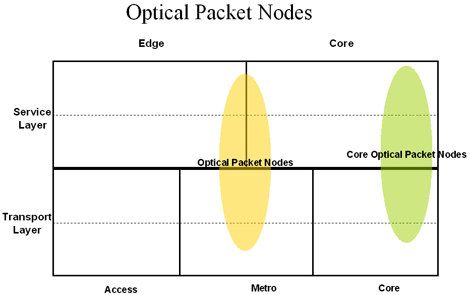 "Optical packet nodes" is a very new term and very new product definition. Optical and packet in the same phrase usually spells trouble: It implies that switching or routing decisions are made through the interpretation of photons, not electrons, which has seemed like something out of science fiction.
"Optical packet nodes" is a very new term and very new product definition. Optical and packet in the same phrase usually spells trouble: It implies that switching or routing decisions are made through the interpretation of photons, not electrons, which has seemed like something out of science fiction.
Optical packet nodes being designed today are not quite ready to perform pure optical packet processing, but they do strive to more closely couple the electronic and optical domains in a single platform. The benefit to the carrier is realized in their efficient use of bandwidth and the higher degree of “intelligence” associated with their transport networks.
Though few vendors exist today, there are two major segments forming: metro and core. Metro optical packet nodes employ sophisticated packet processing to map services into the bandwidth that is most economical and useful for a carrier. Core optical packet nodes act more like terabit routers with optical switching tied to the same platform. Most require nanosecond optical switching to match their electronic counterparts.
It is worth noting here that this is primarily the province of the startup, so most information is not publicly available. These vendors will be announcing throughout the year, so after OFC, Supercomm, and NFOEC we should know much more about the details behind this new product category.
Carrier Wish List“Packet-intelligent” transport networks
Enhanced control over packet flows through the networks to support multiple services with deterministic QOS and verifiable SLAs
Outlook
Hard to say. The technology is relatively immature; carriers have had little or no exposure to these solutions; and just how backbone or metro core networks are going to be built over the next decade remains a very contentious issue within carriers today.
An optical packet node, at least as proposed today, offers a compelling link between the transport and services layer, acknowledging the benefits of making networks as “data-agile” as possible. Will these evolve to true optical routers? Physics will have the last word on this one. Optical memory, storage, queuing, and processing may become feasible in lab environments, but validating their use in telecom gear will be up to network designers.
Related articles in Light Reading
Atoga Tunes Out the Competition
Village Networks: Ahead of the Pack?
Accelight Networks Inc.
Top 10 Trends
Alcatel Settles Suit for a Chunk of Startup
Ilotron Ltd.
Chiaro Gets $100M for "Optical Router"
Startup Touts "First Optical Router"
Chatter's New Box
Vendors
Metro
Atoga Systems
Village Networks Inc.
Core
Accelight Networks Inc.
Chiaro Networks
Ilotron Ltd.
IPOptical Inc.
Luxcore Networks Inc. (previously called Synchordia)
Unannounced
Axiowave Networks Inc.
Next Page: Multilayer Data Switches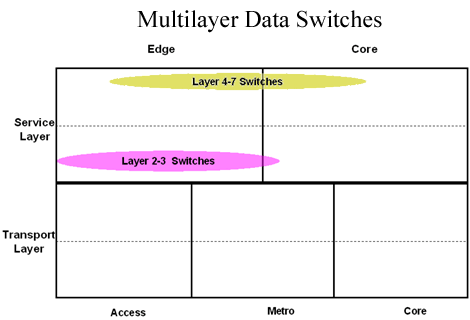 As enterprise applications move into the metro area, so do enterprise switching techniques. A number of vendors making their bread and butter in the enterprise LAN switching space are now entering the metro market with “service-optimized” carrier-class switches, designed to support more than simple LAN switching.
As enterprise applications move into the metro area, so do enterprise switching techniques. A number of vendors making their bread and butter in the enterprise LAN switching space are now entering the metro market with “service-optimized” carrier-class switches, designed to support more than simple LAN switching.
These switches are being primed for service provider networks, leveraging advances in queuing, buffering, policing, and shaping of IP flows. Many of these switches are capable of classifying packets by reading Layers 4-7 information, aggregating them into applications-specific flows to support voice-over-IP or other latency-sensitive services.
Layers 2-3 switches were borne out of enterprise network switching environments, but is currently evolving to support carrier services. Though the typical Layer 2-3 switch is optimized around IP connectivity and line-rate switching, there are more specialized subsets of this product category.
Recently, companies have began focusing on the data center as an emerging bottleneck, requiring its own optimized aggregation and switching solutions. These new systems seek to combine the best of Ethernet switches, SSL (secure sockets layer) accelerators, Web switches, Web caches, load balancers, VPNs, and firewalling gear.
Carrier Wish ListLow-cost, scaleable switching solutions that leverage the economies of scale in LAN switching and the migration toward IP-based metro services
SLA-verifiable services support
Deterministic QOS
Easy migration to 10-gigabit Ethernet
Outlook
The theme of 2000 was definitely multilayer systems. Choosing which layers to integrate was not easy, but most data switch manufacturers found that single-layer switches became easily commoditized and their value to the network remained useful but fairly limited.
New multilayer switches attempt to address specific network opportunities: the data center, the enterprise network, the multitenant market. These are all hot areas, though immature, so look for evolving platforms, a shakeout this year and next, and continued emphasis on the Internet data center as the locus of activity and investment in large carrier networks.
Related articles in Light Reading
Stock Watch: Foundry Networks
Stock Watch: Extreme Networks
Nexsi Nets $75 Million
Nortel Buys Alteon for Big Bucks
Cisco Finds A Soft Spot for ArrowPoint
Force10 Plucks Cisco, Juniper Talent
Vendors
Layers 2-3 Services Switches
Cabletron Systems Inc. (NYSE: CS)
Cisco Systems Inc. (Nasdaq: CSCO)
Extreme Networks Inc. (Nasdaq: EXTR)
Force 10 Networks Inc.
Foundry Networks Inc. (Nasdaq: FDRY)
Nortel Networks Corp. (NYSE/Toronto: NT)
3Com Corp. (Nasdaq: COMS)
Layers 4-7 "Content" Switches
Alteon WebSystems (Nasdaq: ATON)/Nortel
Arrowpoint Communications Inc./Cisco
CacheFlow Inc. (Nasdaq: CFLO)
Inkra Networks Inc.
NetContinuum Inc.
NetScaler Inc.
Nexsi Corp.
Resonate Inc. (Nasdaq: RSNT)
Next Page: Next-Generation Routers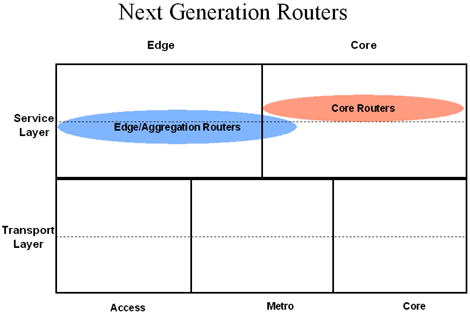 Routers are becoming much more than routers lately, and the term is often considered a bad word. Why? Because routing sounds slow, while switching sounds fast. But routers are getting fast, and with IP emerging as the foundation of all telecommunications services, the router is perhaps the most important product in telecommunications.
Routers are becoming much more than routers lately, and the term is often considered a bad word. Why? Because routing sounds slow, while switching sounds fast. But routers are getting fast, and with IP emerging as the foundation of all telecommunications services, the router is perhaps the most important product in telecommunications.
Look at Cisco and Juniper and you’ll see why. These companies entirely dominate the product category not because they are bullies, but because it is so hard to build a carrier-class router, and it’s extremely difficult to get a data carrier to change their equipment.
So what are new entrants doing? Looking at the edge, where services are created, or deep into the core, where scaling may require entirely new architectures. Cisco and Juniper keep making money -- the startups keep talking. We’ll see how hard it is to get a footprint.
Next-gen routers can be classified as follows:
Edge/Aggregation Routers
These are optimized around deterministic forwarding. These new routers may employ MPLS or utilize advanced network processors and ASICs (application-specific integrated circuits) to process packets at line rates and route both toward the core and the customer. With this capability, these edge routers can support more than packet forwarding to the core and will provide carriers with an IP services infrastructure. Some claim IP-based circuit emulation; some support sophisticated billing possibilities based on workgroup identities, applications, or geographic boundaries.
Core Routers
Core routers are designed to get packets across IP backbones as quickly as possible, from one domain to the next or one service provider backbone to the next. Core routers are evolving their traffic management capabilities with MPLS, and increasing their capacities with the adoption of OC192 interfaces. This market contains two factions: the Cisco/Juniper camp that is going after the bread-and-butter Internet routing market; and the terabit/petabit router camp, those startups going after the heart of IP networks with very high-capacity switch/routers.
Outlook
Huge. That simple. If the world is going IP, wouldn’t you want to be making the equipment that moves those packets through the network?
Then again, it’s not that simple. Cisco and Juniper have a lock on the core Internet router market and continue to expand their product lines to address emerging applications for routers in carrier and service provider networks. New entrants face a difficult battle standing out, even if their technology is in some ways superior.
Juniper was able to break in by providing a very stable routing platform based on their own custom ASICs and fresh software unencumbered by Cisco’s mega-multi-revisioned IOS. But most IP carriers want only two suppliers of routers and they are loath to tear out core equipment unless something really exciting comes along. This is definitely a growth market, but as with the airline industry, only a few jumbo jet manufacturers can survive.
Related articles in Light Reading
Report: Juniper Still Gaining On Cisco
Pluris Is Back
Charlotte's Web Weaves In TDM
Lucent Quiets Terabit Router Rumors
Hyperchip Hypes Its Hardware
Nortel Discloses Terabit Router Plans
Internet Pioneer Plots IP Revolution
Alcatel Takes On Juniper
Ed Kozel Is Back at Cisco
Alcatel Settles Suit for a Chunk of Startup
Terabit Turmoil
Chatter's New Box
Laurel Networks Scores Big Round
Chiaro Gets $100M for "Optical Router"
Vendors
Edge/Aggregation Routers
Alcatel SA (NYSE: ALA; Paris: CGEP:PA)
Amber Networks Inc.
Cisco Systems Inc. (Nasdaq: CSCO)
Gotham Networks
Juniper Networks Inc. (Nasdaq: JNPR)
Laurel Networks
Nortel Networks Corp. (NYSE/Toronto: NT)
Redback Networks Inc. (Nasdaq: RBAK)
Riverstone Networks (Nasdaq: RSTN)
Unisphere Networks Inc. (Nasdaq: UNSP) (Redstone)
Core Switch/Routers
Alcatel SA (NYSE: ALA; Paris: CGEP:PA)
Avici Systems Inc. (Nasdaq: AVCI; Frankfurt: BVC7)
Caspian Networks
Charlotte’s Web Networks Ltd.
Cisco Systems Inc. (Nasdaq: CSCO)
Hyperchip Inc.
Juniper Networks Inc. (Nasdaq: JNPR)
Lucent Technologies Inc. (NYSE: LU) (Nexabit)
Marconi Communications PLC (Nasdaq/London: MONI)
Nortel Networks Corp. (NYSE/Toronto: NT)
Pluris Inc.
Procket Networks Inc.
Unisphere Networks Inc. (Nasdaq: UNSP) (Argon)
You May Also Like
.jpeg?width=300&auto=webp&quality=80&disable=upscale)








